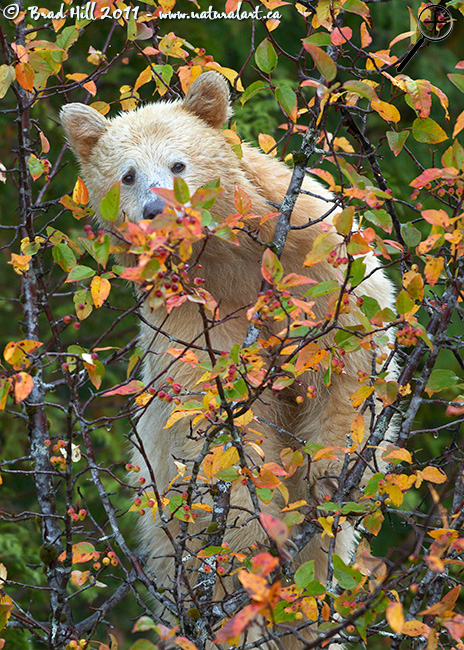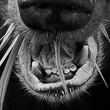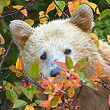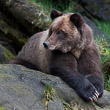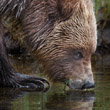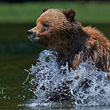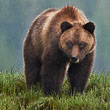Availability: Undetermined - Enquiries?
In the Field
Peekaboo! Great Bear Rainforest (central BC coast), BC, Canada. October 11, 2007.
During a recent image catalog cleaning spree I ran across this "archaic" image (from WAY BACK in 2007!) sitting in raw, unprocessed form. Makes me glad I took the time to clean house a little...
The subject is, of course, one of the extremely rare white-coated Black Bears known as "Spirit Bears" found in a small part of the Great Bear Rainforest along the central and northern BC coast. We encountered this one in an old logging cut-block just above the shoreline as it was foraging in a colourful crabapple tree in its full fall splendour. This image was captured from the deck of a sailboat as we cruised along parallel to the shoreline.
If you take the time to look at the larger version of the image you'll note the crop is different than the "standard" sized image seen directly above. This was intentional on my part - the standard image is the crop I chose for online presentation and the larger one is the crop I would use to PRINT the image. I often use quite different crops for online vs. print presentation.
The obvious question here is "Why do I do this?" While many images look great online, not all do - especially if one is showing the full-frame image (in resolution-reduced form). Reducing the resolution of an image (in this case for presentation on a computer screen) can have several beneficial effects, such as reducing image noise and making a less-than-tack-sharp image appear sharper. BUT, at the same time, resolution reduction for electronic display is always accompanied by a loss of image data and thus image detail. When it comes to wildlife images, this often means the very fine detail visible in the full-res version (such as the individual hairs or feather detail on the subject's luxuriant coat or plumage) is lost. There are LOTS of time this loss of detail isn't critical - after all the success of MANY images isn't dependent on super fine detail being visible (which is fortunate for many users of sub-standard lenses!). BUT...in some images showing that fine detail can add a lot to the image. In the case of this image, seeing the individual hairs on its coat and the reflections in the bear's eyes (both of which wouldn't have been very visible if I showed the full-frame image with a total height of 650 pixels) contributes a lot to the image.
NOTE: This image was captured in a region of British Columbia known as "The Great Bear Rainforest". I offer both instructional photo tours and "photo op only" photo tours into the Great Bear Rainforest each spring and autumn. If you're interested in more information about one of these tours, details are available on the Photo Tours page of this website!
Behind the Camera
Peekaboo! Great Bear Rainforest (central BC coast), BC, Canada. October 11, 2007.
Digital Capture; RAW 14-bit format; ISO 250.
Nikon D2X with Nikkor 200-400mm f4 VR zoom lens @ 400mm (600mm EFL) supported on Gitzo 1348 tripod with Wimberley head. VR on and set to "Normal" mode.
1/250s @ f5; -0.33 stop compensation from matrix-metered exposure setting.
At the Computer
Peekaboo! Great Bear Rainforest (central BC coast), BC, Canada. October 11, 2007.
RAW Conversion to 16-bit TIFF, including first-pass/capture sharpening using Phase One's Capture One Pro 6.
Further digital corrections on 16-bit TIFF file using Adobe's Photoshop CS5 and Light Craft's LightZone. Photoshop adjustments included selective exposure and tone curve adjustment, selective colour saturation and desaturation, and selective sharpening for web output. Final tonemapping and contrast/tone tweaking - especially to midtones - performed with LightZone using the tonemapper/re-light tool.
Conservation
Peekaboo! Great Bear Rainforest (central BC coast), BC, Canada. October 11, 2007.
Ten percent of the revenue generated by this image will be donated to Raincoast*.
Species Status in Canada**: Not currently listed as Threatened or Endangered.
This Spirit Bear is a member of the subspecies "Kermodei" of American Black Bear (Ursus americana kermodei). This subspecies is unique in that the population is characterized by having an unusually high proportion of a recessive gene that produces white coat colour (found on the "Spirit Bears"). Because the Black Bear is not considered under threat as a species, both the Kermodei subspecies and the very rare Spirit Bear suffer from having the same conservation designation (it should be acknowledged that in British Columbia - the jurisdiction of greatest Spirit Bear abundance - hunting of these white-coated bears is not permitted). For reasons that are not fully understood, the Spirit Bear occurs with greater frequency in a relatively small geographic area within The Great Bear Rainforest of the central and northern coast of British Columbia. In this area 10 to 30% of the bears possess white coats. Many of the black-coloured Black Bears in this region carry the gene for white coats, so allowing hunting of ANY Black Bears in this region can reduce the frequency of the gene for white coats. Thus, to protect the Spirit Bear, it is necessary to prohibit the hunting of ALL Black Bears in this region. And, very unfortunately, the globally unique ecosystem that contains the Spirit Bear is under development pressure, especially from the forestry industry. If this unique environment is altered, we may lose the wonderful genetic anomaly known as the Spirit Bear forever.
*The Raincoast Conservation Society (and Foundation) is an effective and efficient organization that has been fighting for protection of this unique habitat. If you are looking for a meaningful way to contribute to the conservation of this amazing ecosystem, Raincoast will provide maximal "bang" for your conservation dollars.
**as determined by COSEWIC: The Committee on the Status of Endangered Wildlife in Canada












